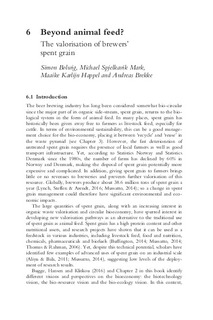Beyond animal feed? The valorisation of brewers’ spent grain
Chapter, Peer reviewed
Published version

Åpne
Permanent lenke
http://hdl.handle.net/11250/2600005Utgivelsesdato
2019Metadata
Vis full innførselSamlinger
Originalversjon
Bolwig, S., Mark, M. S., Happel, M. K. & Brekke, A. (2019). Beyond animal feed? The valorisation of brewers’ spent grain. In A. Klitkou, A. M. Fevolden & M. Capasso (Eds.), From Waste to Value: Valorisation Pathways for Organic Waste Streams in Circular Bioeconomies (107-126). Abingdon, Oxon: Routledge.Sammendrag
The beer brewing industry has long been considered somewhat bio-circular since the major part of its organic side-stream, spent grain, returns to the biological system in the form of animal feed. In many places, spent grain has historically been given away free to farmers as livestock feed, especially for cattle. In terms of environmental sustainability, this can be a good management choice for the bio economy, placing it between ‘recycle’ and ‘reuse’ in the waste pyramid (see Chapter 3). However, the fast deterioration of untreated spent grain requires the presence of local farmers as well as good transport infrastructure. Yet, according to Statistics Norway and Statistics Denmark since the 1980s, the number of farms has declined by 60% in Norway and Denmark, making the disposal of spent grain potentially more expensive and complicated. In addition, giving spent grain to farmers brings little or no revenues to breweries and prevents further valorisation of this resource. Globally, brewers produce about 38.6 million tons of spent grain a year (Lynch, Steffen & Arendt, 2016; Mussatto, 2014); so a change in spent grain management could therefore have significant environmental and economic impacts.
